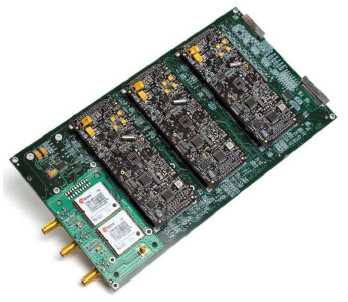MicroPilot 21283X
How long before this becomes a standard required by authorities??
The MP21283X, MicroPilot’s triple-redundancy (3X) autopilot, is now available. Although 3X technology is established within the aviation industry, 3X autopilots are a new addition to unmanned aerial vehicles (UAVs). The MP21283x contains three robust autopilots to overcome a multitude of hardware failures. If any one of the three autopilots should fail, the remaining two take over. An additional mechanism oversees these three systems.

Comments
Not sure about redundant microcontrollers, but redundant GPS is the next big need. That is the biggest problem. You don't know your electronics are interfering until it's too late.
"looks pretty fragile"
The board has 10 screws at least for tightening it to moutn points.
About failsafe system: if we put 1 system in serial and 3 (previously untrusted) in parallel,
we can minimize the chance of failure only if the supervisor is much more reliable tested and mature than any of the elements it parallelizes.
This can be done if the supervisor is dead simple.
The problem is they made 'suprisingly advanced' supervisor that is maybe 100 times less popular than the autopilots. And here are the problems. If the double power would be inherent part of micropilot etc parallelizing would make sense. But if the supervisor board is assuring the mission synchronization and all the things PLUS power, then we see a picture, that the board is fixing all the parallelization-related deficiencies that hasn't been considered at the time of basic autopilot design. It is giving only partial boost in security, for a high creation effort, room and price.
I don't think we will see many sub 1k public UAS in the USA.
You can expect standalone failsafes like the http://www.millswoodeng.com.au/failsafe_device.html
I thought two different makes of GPS was a good idea, I have asked Dean about it loads of times!
hmm now let me look at this $6K for 1 board?
lets see I dont think the average drone exceeds $1K yet alone this board is huge
maybe for a 6 million dolar preditor
so what hapens if the "oversee'er" hardware fails? then plop a dead chunk of $6K parts
and is this board crash proof? looks pretty fragile
"Reliable autopilots are a good thing, be it for missile guidance or your 50cc powered mega model."
This is why most commercial applications make sense when you fly AWAY from build up areas. Mining, precision agriculture, road constructions, mapping of sparsely populated areas.
I made components for standoff missile systems for 15 years. This level of redundancy is not uncommon in munitions that fly 200 miles to target with 500 to1000 lb warheads. You don't want it coming down on the good guys.
What would happen if your "Model" UAV came down in a day care playground and injured a little kid? The lawyers would be lining up to sue you for all you have.
Reliable autopilots are a good thing, be it for missile guidance or your 50cc powered mega model.
@jared obviously this board is pointed at people making more sophisticated platforms for commercial and government use. the same kind of system that will probably also require a transponder as well as some type of see/avoid system. in other words, something where you need to file a flight plan and/or would rather not have it land in the middle of the bad guys after a system failure. i am not sure how they are handling redundancy on the electro-mechanical side - like servos - but there are probably redundant systems and/or large safety factors in design anyplace where a single point of failure could cause the airframe to stop flying. triple redundancy is typical in avionics systems that are placed in-line between the person who wiggles the sticks and the control surfaces being wiggled i.e. fly-by-wire. and we are also now replacing the person wiggling the sticks, so who knows...
all that said, i do not think the DIY crowd is too many months away from being able to have redundant systems at the same size/cost as the single systems we have today.
-
1
-
2
-
3
-
4
-
5
of 5 Next